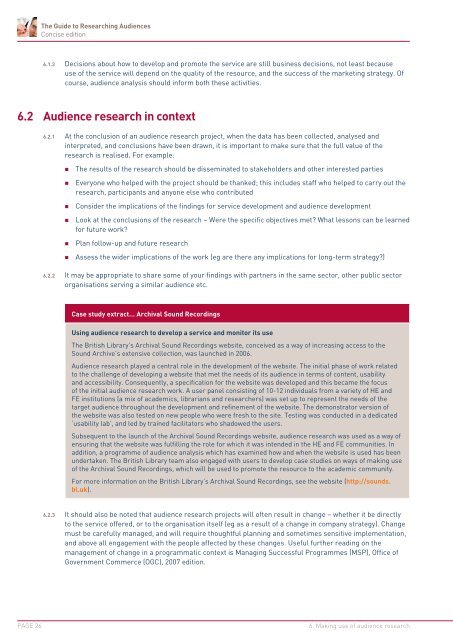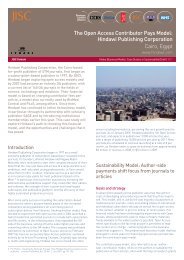A Concise Guide to Researching Audiences - Strategic Content ...
A Concise Guide to Researching Audiences - Strategic Content ...
A Concise Guide to Researching Audiences - Strategic Content ...
Create successful ePaper yourself
Turn your PDF publications into a flip-book with our unique Google optimized e-Paper software.
The <strong>Guide</strong> <strong>to</strong> <strong>Researching</strong> <strong>Audiences</strong><strong>Concise</strong> edition6.1.3 Decisions about how <strong>to</strong> develop and promote the service are still business decisions, not least becauseuse of the service will depend on the quality of the resource, and the success of the marketing strategy. Ofcourse, audience analysis should inform both these activities.6.2 Audience research in context6.2.1 At the conclusion of an audience research project, when the data has been collected, analysed andinterpreted, and conclusions have been drawn, it is important <strong>to</strong> make sure that the full value of theresearch is realised. For example:• The results of the research should be disseminated <strong>to</strong> stakeholders and other interested parties• Everyone who helped with the project should be thanked; this includes staff who helped <strong>to</strong> carry out theresearch, participants and anyone else who contributed• Consider the implications of the findings for service development and audience development• Look at the conclusions of the research – Were the specific objectives met? What lessons can be learnedfor future work?• Plan follow-up and future research• Assess the wider implications of the work (eg are there any implications for long-term strategy?)6.2.2 It may be appropriate <strong>to</strong> share some of your findings with partners in the same sec<strong>to</strong>r, other public sec<strong>to</strong>rorganisations serving a similar audience etc.Case study extract… Archival Sound RecordingsUsing audience research <strong>to</strong> develop a service and moni<strong>to</strong>r its useThe British Library’s Archival Sound Recordings website, conceived as a way of increasing access <strong>to</strong> theSound Archive’s extensive collection, was launched in 2006.Audience research played a central role in the development of the website. The initial phase of work related<strong>to</strong> the challenge of developing a website that met the needs of its audience in terms of content, usabilityand accessibility. Consequently, a specification for the website was developed and this became the focusof the initial audience research work. A user panel consisting of 10-12 individuals from a variety of HE andFE institutions (a mix of academics, librarians and researchers) was set up <strong>to</strong> represent the needs of thetarget audience throughout the development and refinement of the website. The demonstra<strong>to</strong>r version ofthe website was also tested on new people who were fresh <strong>to</strong> the site. Testing was conducted in a dedicated‘usability lab’, and led by trained facilita<strong>to</strong>rs who shadowed the users.Subsequent <strong>to</strong> the launch of the Archival Sound Recordings website, audience research was used as a way ofensuring that the website was fulfilling the role for which it was intended in the HE and FE communities. Inaddition, a programme of audience analysis which has examined how and when the website is used has beenundertaken. The British Library team also engaged with users <strong>to</strong> develop case studies on ways of making useof the Archival Sound Recordings, which will be used <strong>to</strong> promote the resource <strong>to</strong> the academic community.For more information on the British Library’s Archival Sound Recordings, see the website (http://sounds.bl.uk).6.2.3 It should also be noted that audience research projects will often result in change – whether it be directly<strong>to</strong> the service offered, or <strong>to</strong> the organisation itself (eg as a result of a change in company strategy). Changemust be carefully managed, and will require thoughtful planning and sometimes sensitive implementation,and above all engagement with the people affected by these changes. Useful further reading on themanagement of change in a programmatic context is Managing Successful Programmes (MSP), Office ofGovernment Commerce (OGC), 2007 edition.PAGE 266. Making use of audience research



